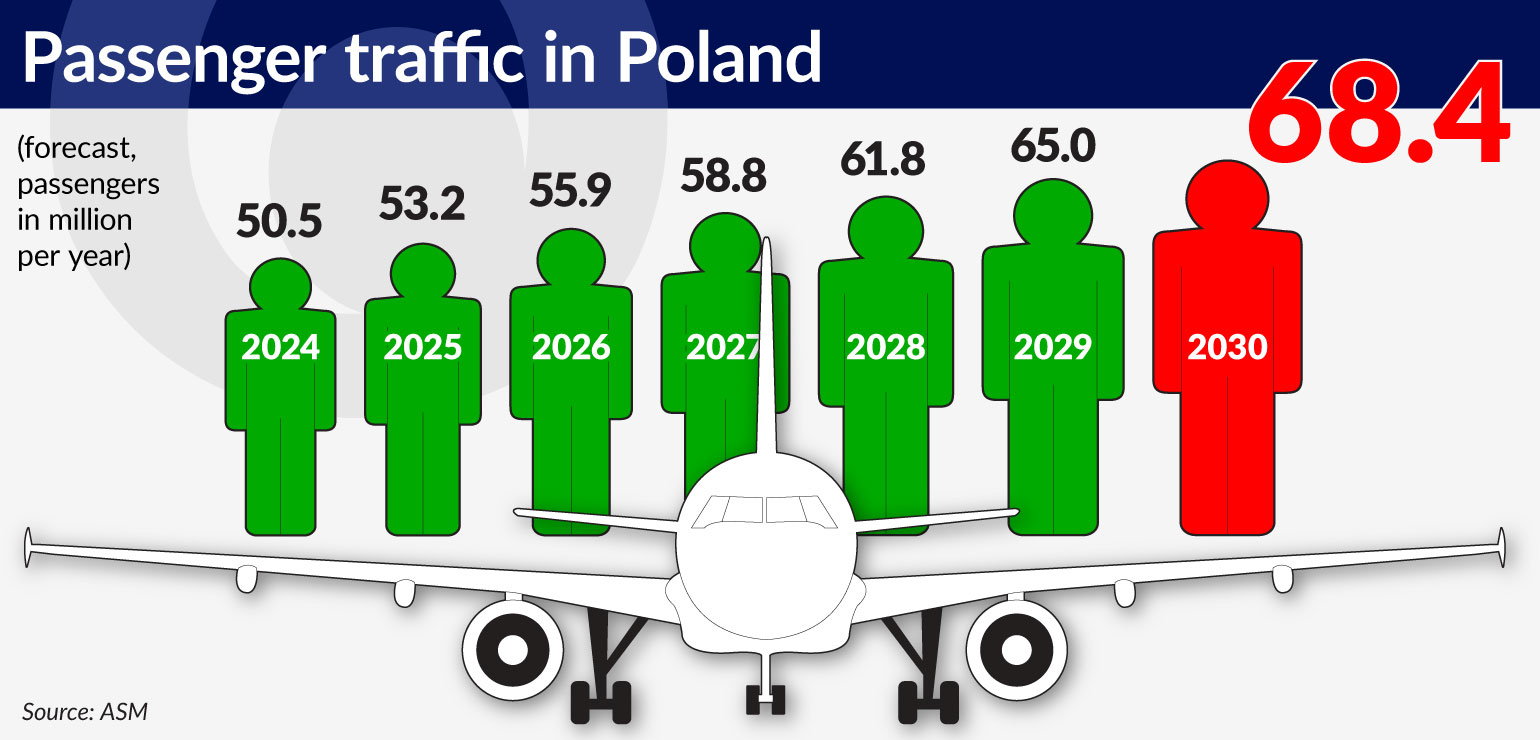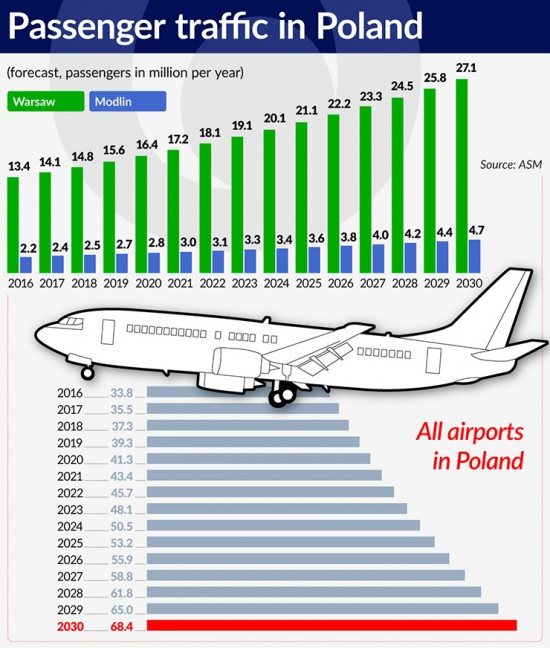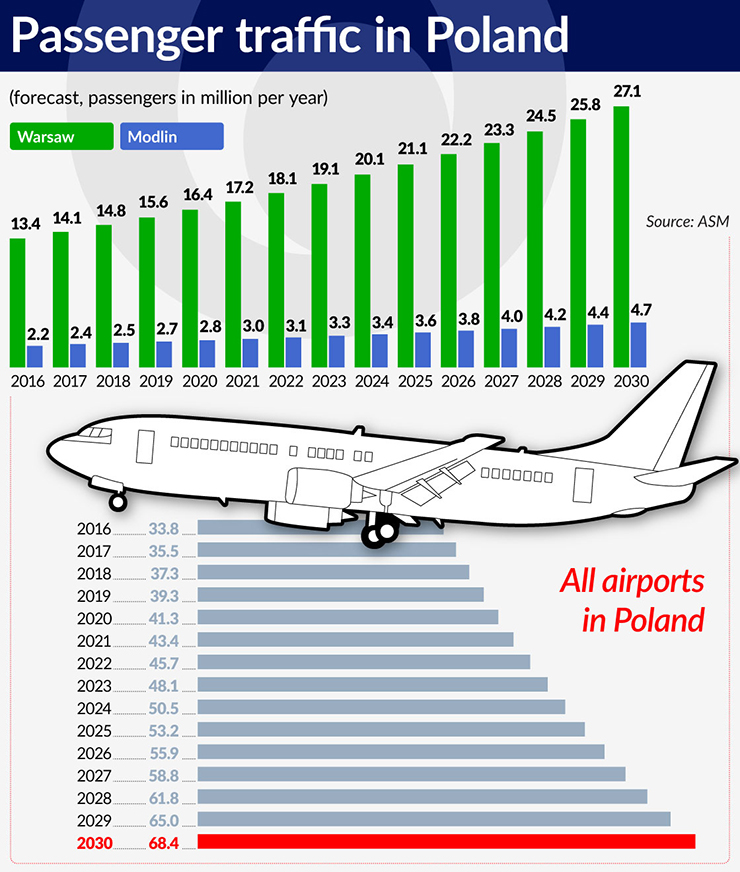Tydzień w gospodarce
Category: Raporty

(Infographic Łukasz Rosocha)
At least 15 years must be earmarked for the entire investment process from the decision to build a new airport to its opening (especially in the case of an airport so large that it could replace Warsaw airport in the future). Historical examples of other countries show that even such time may be too short. Until then, the existing Chopin airport at Warsaw’s Okęcie district must be able to handle all the carriers and passengers.
Meanwhile, the dynamics of air traffic and forecasts for the future indicate that the airport may reach its maximum capacity as early as 2024-2026. According to the forecast prepared by the ASM company, about 760 take-offs and landings may take place in Warsaw every day in that period during the summer months. Such a number of flights is – at least for now – the limit of the airport’s capabilities.

(Infographic Łukasz Rosocha)
Even taking the latter date, i.e. 2026, as the deadline – it is rather unfeasible to build a new central airport in such a short time, however efficient the organization of the project is. If no prompt decision is made to ensure the ability to handle the growing air traffic, Poland may lose its clientele to other countries – along with the huge associated benefits.
The solution to this problem in the short term would be to increase the capacity of Chopin Airport with the least expenditure of resources to ensure that it is capable of efficiently and comfortably handling the growing air traffic for at least another few years. During this time, it would be possible to decide on a new airport and to build it, or to implement other solutions to ensure the optimal development of air transport in Poland for many years ahead.
The most obvious alternative to the construction of a new airport from the scratch in an entirely new location is the concept of cooperation between Chopin and Modlin (an airport situated 40 km from Warsaw and used by low-cost airlines) airports, with the assumption that after Warsaw airport reaches the limits of its capacity, the increasing air traffic will be taken over by Modlin in the following years.
Similar solutions have been adopted in the construction of Gardemoen airport near Oslo or the new Brandenburg airport for Berlin in the immediate vicinity of the existing Schönefeld airport.
In order to gain some extra time for reaching a decision on airport expansion and the shape of final investment, the easiest move increasing the capacity of Chopin airport would be to abolish the limits on night time flights. Currently, there is a ceiling of 40 flights imposed on the airport’s operations between 10 PM and 6 AM, while during the day the airport can handle about 45 take-offs and landings per hour. Such a solution would provide additional time, but would not eliminate the next challenge, i.e. the risk of the airport terminal complex becoming clogged.
The estimates prepared by the company ARUP indicate that after the last expansion, completed last year, the capacity of the Warsaw terminal is approx. 26.6 million passengers per year. From the analysis put forward by the company ASM it follows that in 2030 all Polish airports will handle a total of 68.4 million passengers, while last year they ferried 30.4 million. Over this time, the number of travelers transiting through Warsaw airport is expected to increase from 11.9 to 27.14 million.
This means that around 2030 the currently existing terminal may to be too small. According to more optimistic forecasts (ASM estimates are quite conservative) that could happen as quick as 2028. On the one hand, this is a few years later than the above-mentioned horizon of 2024-2026, but on the other hand, it is only 12-14 years from now. It is not such a remote future, if we take into account the time that has to elapse between the adoption of a final decision on an investment as complex as the construction of a new airport and its completion.
It is enough to recall the last expansion, which began in 2000 when the first tender – or rather a competition – for the construction of the 2nd terminal of the Warsaw airport was announced. The contract for its construction was signed in November 2002, and it was envisaged that the contractor would have a year to obtain a building permit, and another two for the construction. The works were therefore supposed to have been completed in 2005, but the first delays occurred already at the stage of obtaining the building permit. The new terminal ultimately began handling departures in March 2008.
The thorough modernization of the old Terminal 1, which can be seen as the completion of the investment initiated by the tender announced in 2000, was carried through only in 2015. This means that 15 years elapsed from the launch of the series of investments to their completion, and it is worth noting that the project did not involve the construction of a new airport, but an extension only.
With some technical efforts and relatively small investments Warsaw could probably gain a few additional years until it reaches the limit of its capacity in approximately 2035-2037. This would provide the government with a bit more freedom in decision making; however, the time gained should not be spent on futile multiplication of analyses, but on providing reliable answers to some key questions.
First of all, Poland should definitively determine whether it needs a new central airport built from scratch or whether its role could be fulfilled by the already existing infrastructure, amenable to expansion in the future.
The authors of the report „The concept of a Central Airport for Poland”, drawn up in 2010 by Oliver Wyman, PWC, MKMetric and DFS (a company established for the management of air traffic in German airspace) stated unequivocally that Poland needs a new airport, and that the decision on its construction should be taken by the end of 2010. The alternative scenario considered in the report was a further expansion of Chopin airport as the central airport for Poland. The authors of the report assumed that the construction of the new airport would start at the beginning of 2015. In such a case it would initiate its operations in early 2021.
This schedule is extremely optimistic and in order to make it more realistic – and not just because the key years 2010 and 2015 have already gone by – at least another 5 years should be added. The construction of a new airport from scratch would entail not only the need to select a location (the report does not suggest any particular one), but also the construction of new infrastructure ensuring efficient transportation of passengers and airport employees.
One reason to conclude that 11 years constitutes far too short period to build a new airport following the adoption of an investment decision is the example of the new Berlin airport. The company established for its construction was founded in 1991, and already at that point it was clear that in the future the capital of the recently reunited Germany would have a new airport in place of the existing facilities.
The final decision on the selection of the location was adopted 5 years later. The construction works began in September 2006 and at that point it was expected that the airport would be launched in 2012. The currently provided date of its launch is the second half of 2017, and the media have been speculating for several months that this date is uncertain as well.
However, if the new Berlin airport launches operations next year, that will be 26 years from the start of the project and 11 years from the initiation of construction works.
Another example is Munich, where the construction itself took 12 years and 23 years passed from the decision to build the new airport to its launch (from 1969 to 1992). The preparations for the construction of the new de Gaulle airport in Paris began in 1957, and the construction itself lasted from 1966 to 1974.
An interesting example is Gardermoen airport, which supports the capital of Norway, Oslo. The final decision that this former military airport will be the new airport for the capital city was adopted in 1992. The transfer of the whole traffic from the existing Fornebu airport occurred on the night from the 7th to 8th October, 1998, i.e. after a much shorter time than in the Berlin case. However, the discussions about the location of the new airport began in 1970.
Let’s hope that the designers and builders of the new airport for Warsaw, if such a decision is made, are able to avoid serious errors like the ones made in Berlin, but the assumption that a new airport built from scratch will be launched 11 years after the decision is adopted remains unrealistic.
The authors of the report „The concept of a Central Airport for Poland” did not carry out a thorough analysis of the concept of a cluster of airports which could serve as the central airport facility. In Polish conditions such a system could include Chopin airport and Modlin airport, the latter taking over all the new traffic after 2035, with the prospect of becoming the main Warsaw airport, pending subsequent development.
The authors of the report limited themselves to stating that a multiple-airport system does not provide optimal support for the developing air transport in Poland and that it cannot optimize the number of connections (but this position was not elaborated).
The fact that airport clusters can work, provided their cooperation is well coordinated, is evidenced by London which is the largest European air hub. It consists of Heathrow, Gatwick, Stansted and Luton airports, as well as the smallest one, City airport (handling more than 4 million passengers per year). Clusters of two and more airports also support the air traffic around Paris, New York, Tokyo and Houston.
Lower costs are one of the main advantages of developing the infrastructure of the two existing airports rather than building a new airport from scratch. This is mainly due to the fact that transport infrastructure around the two airports has already been developed (even if we take into account the need for the expansion of roads and railway lines to Modlin).
The concept of a cluster of airports also has the advantage that the infrastructure of Chopin airport would be used for many years to come and as a result the money invested in the last expansion (including the construction of the railway line) would pay off. This would not be so certain if the airport was to be closed around 2030. Another argument is that Modlin has successfully passed the market test, is growing each year with 2.6 million passengers last year.
The opponents of the construction of a new airport recall the story of Canada’s Mirabel airport which was supposed to provide services for Toronto, replacing Dorval airport. Mirabel was launched in 1975 and met its symbolic end with the demolition of the terminal complex in 2014. Meanwhile, Dorval handled nearly 15.5 million passengers last year.
One of the strongest arguments in favor of the construction of a new airport replacing Chopin Airport is the substantial amount of money that could be obtained from the sale of land for the airport. Another important point is that local residents would be spared the aircraft noise (even though the nuisance of the newest airplanes is increasingly smaller).
A significant risk factor in the determination of the new airport’s location is the influence of powerful lobbies which will try to obtain profits regardless of whether the proposed location is objectively the optimal one.
Even in countries as stable and transparent as Norway and Germany, disputes about the location of the airport and the implementation of the investment were ridden with scandals – allegations of corruption, and even an unexplained death of an engineer who claimed that false weather data were included in the analyses concerning the location of the airport for Oslo. This shows that the prospect of completing an investment worth billions may be a serious temptation.
Regardless of what decision is taken with regard to the future expansion of the airport infrastructure around Warsaw, there is less and less time to make it. Nonetheless, despite the time pressure, officials involved in the resolution of this dilemma should issue their verdict with caution, taking into account multiple criteria, including those difficult to accommodate within a financial framework, and their decision should be taken irrespective of the pressure of interest groups, which are led, first and foremost, by their own interest.

